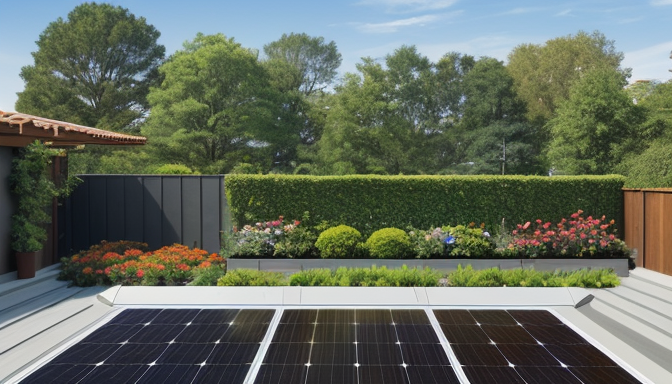Have you ever thought about what it would be like to generate your own electricity? Solar panels make this dream a reality, transforming your home into a self-sufficient energy powerhouse. By harnessing the sun’s energy, these panels allow you to produce electricity right from your rooftop, reducing your reliance on traditional power grids. Imagine waking up every day knowing that the energy powering your home comes from a clean, renewable source. It’s like having your very own energy factory!
So, how do these remarkable devices work? At the heart of solar technology is the photovoltaic (PV) process, where sunlight is converted into electricity. Solar panels are made up of many individual solar cells, typically composed of silicon. When sunlight hits these cells, it excites electrons, creating a flow of electricity. This process not only provides you with power but does so in an environmentally friendly way, helping to reduce your carbon footprint.
But the benefits go beyond just independence from the grid. By installing solar panels, homeowners can enjoy significant cost savings on their electricity bills. In fact, many users report slashing their energy expenses by up to 50% or more! And let’s not forget about the empowerment that comes from generating your own electricity. You’re not just a consumer; you become a producer, taking control of your energy future.
In summary, solar panels are more than just a trend; they represent a shift towards a sustainable lifestyle. With advancements in technology and increasing affordability, there’s never been a better time to consider making your home independent. So why wait? The sun is shining, and your energy independence is just a panel away!
The Basics of Solar Panel Technology
Understanding how solar panels work is crucial for homeowners considering this technology. At the heart of solar panels lies the photovoltaic (PV) process, which is essentially nature’s way of converting sunlight into electricity. Imagine sunlight as a powerful source of energy, much like a river flowing with potential. Just as we harness water to generate power, solar panels capture sunlight and transform it into usable energy.
Solar panels are made up of many individual solar cells, typically composed of silicon. These cells work together to create a solar module. When sunlight strikes these cells, it excites electrons, creating a flow of electricity. This process can be summarized in a few simple steps:
- Sunlight hits the solar cells.
- Electrons are knocked loose, generating direct current (DC) electricity.
- A solar inverter converts DC electricity into alternating current (AC), which is what your home uses.
- Excess energy can be stored in batteries or sent back to the grid.
But wait, there’s more! The efficiency of solar panels is influenced by several factors, including:
| Factor | Impact on Efficiency |
|---|---|
| Sunlight Intensity | More sunlight equals more electricity generated. |
| Temperature | Higher temperatures can reduce efficiency. |
| Panel Orientation | Optimal angles can maximize sunlight exposure. |
In essence, solar panels are an incredible fusion of technology and nature, allowing us to tap into a renewable energy source that is both abundant and sustainable. By understanding the basics of how these systems operate, you can make informed decisions about integrating them into your home. So, are you ready to harness the sun’s power?

Benefits of Energy Independence
Imagine waking up in the morning, flipping on the lights, and knowing that your energy comes from the sun. That’s the magic of solar panels! Achieving energy independence through solar power isn’t just a trend; it’s a revolution that can transform your home and lifestyle. One of the most significant benefits is the potential for cost savings. By generating your own electricity, you can significantly reduce or even eliminate your monthly utility bills. Over time, these savings can accumulate to thousands of dollars, making your investment in solar panels incredibly worthwhile.
But the perks don’t stop at your wallet. There’s also a positive environmental impact. Solar energy is a clean, renewable resource that reduces your carbon footprint. Every kilowatt-hour (kWh) of electricity you produce from solar means less reliance on fossil fuels, which contributes to a healthier planet. Think of it as your personal contribution to fighting climate change—every little bit helps!
Moreover, there’s an empowering feeling that comes with generating your own electricity. It’s like having your own little power plant right on your roof! This independence from traditional energy sources not only provides stability against rising energy costs but also grants you control over your energy consumption. You can tailor your energy use to fit your lifestyle, making it easier to embrace sustainable living.
In essence, the benefits of energy independence through solar panels are multifaceted. From financial savings to environmental stewardship and personal empowerment, solar energy can truly change the way you live. So, why not take the leap? Your future self will thank you!
Installation and Maintenance Considerations
When it comes to installing solar panels, the process is more than just slapping a few panels on your roof and calling it a day. It’s a meticulous journey that begins with careful planning and consideration. First off, you need to assess your home’s energy needs. This means understanding how much energy you consume on a daily basis. By calculating your average monthly electricity usage, you can determine the size and number of solar panels required to meet your needs.
Next, selecting the right location for installation is crucial. Ideally, solar panels should be placed in an area that receives maximum sunlight exposure throughout the day. This often means positioning them on a south-facing roof. However, if your roof isn’t suitable, ground-mounted systems are also an option. It’s important to avoid shaded areas from trees or buildings, as even a small amount of shade can significantly reduce efficiency.
Once the location is determined, hiring a professional installer is highly recommended. They will ensure that your system is installed correctly and safely, adhering to all local building codes and regulations. This is where expertise comes into play; a professional can navigate the technicalities that a DIY enthusiast might overlook.
But installation is just the beginning. After your panels are up and running, regular maintenance is key to keeping your system efficient. This includes:
- Cleaning: Dust, debris, and bird droppings can accumulate on your panels, reducing their efficiency. A simple rinse with water can do wonders.
- Inspections: Schedule annual check-ups to ensure everything is functioning properly. Look out for any signs of wear and tear.
By staying proactive about maintenance, you can extend the lifespan of your solar panels and maximize your investment. The journey to energy independence doesn’t stop at installation; it’s an ongoing commitment to ensuring your home remains a self-sufficient powerhouse.

Financial Incentives and Rebates
When it comes to investing in solar panels, one of the most exciting aspects is the array of financial incentives and rebates available to homeowners. These incentives not only make solar energy more accessible but also significantly reduce the overall cost of installation. Imagine being able to harness the sun’s energy while also receiving financial support from your government! It’s like getting paid to go green!
In the United States, for instance, the federal government offers a solar investment tax credit (ITC) that allows homeowners to deduct a substantial percentage of their solar installation costs from their federal taxes. As of 2023, this credit stands at 30%, which can translate to thousands of dollars in savings. Additionally, many states and local governments provide their own incentives, which can further lower your upfront costs.
To give you a clearer picture, here’s a table highlighting some common financial incentives:
| Incentive Type | Description |
|---|---|
| Federal Tax Credit | 30% deduction on solar installation costs |
| State Tax Credits | Varies by state; can significantly reduce costs |
| Rebates | Cash incentives from local governments or utility companies |
| Net Metering | Credits for excess energy produced by your solar panels |
Moreover, many utility companies offer net metering, a program that allows you to receive credits for the excess electricity your solar panels generate. This means that on sunny days, when your system is producing more energy than you need, you can send that energy back to the grid and receive credits on your utility bill. It’s like having a savings account for your energy!
In conclusion, the financial incentives and rebates available for solar panel installation can significantly enhance the affordability of transitioning to renewable energy. By leveraging these opportunities, homeowners not only save money but also contribute to a more sustainable future. So, why not take advantage of these incentives and make your home a beacon of energy independence?
Future of Solar Energy in Homes
The future of solar energy in homes is not just bright; it’s positively **radiant**! With rapid advancements in technology, solar panels are becoming more efficient, affordable, and versatile. Imagine a world where your home generates all the energy it needs, allowing you to turn off the grid and embrace **complete independence**. This isn’t just a dream; it’s becoming a reality for many homeowners.
One of the most exciting trends is the development of **solar shingles**. Unlike traditional panels, these are integrated into the roof itself, providing a sleek and aesthetically pleasing solution. Homeowners no longer need to compromise on style for sustainability. Plus, innovations in battery storage technology mean that you can store excess energy generated during sunny days for use at night or during cloudy weather. This capability ensures that your home remains powered, no matter the conditions outside.
Furthermore, as governments around the world push for greener initiatives, we can expect to see more **incentives and rebates** for solar energy installations. This support not only makes solar energy more accessible but also encourages homeowners to invest in their own energy solutions. In fact, many experts predict that by 2030, solar energy could power a significant portion of homes, leading to a **dramatic decrease** in reliance on fossil fuels.
As we look ahead, the integration of **smart home technology** with solar energy systems is also on the rise. Imagine controlling your energy usage from your smartphone, optimizing your consumption in real-time, and even selling excess energy back to the grid! The potential for innovation is limitless, and the idea of a self-sustaining home is closer than ever.
In conclusion, the future of solar energy in homes is not only about harnessing the sun’s power but also about creating a **sustainable lifestyle** that benefits both the homeowner and the planet. As technology continues to evolve, we can all look forward to a greener, more independent future.
Frequently Asked Questions
- How do solar panels actually work?
Solar panels work by converting sunlight into electricity through the photovoltaic effect. When sunlight hits the solar cells, it excites electrons, creating a flow of electricity. This process is what allows your home to generate its own power!
- What are the main benefits of using solar panels?
Using solar panels can significantly reduce your electricity bills, lower your carbon footprint, and increase your home’s value. Plus, there’s something empowering about producing your own energy!
- How much maintenance do solar panels require?
Solar panels are quite low-maintenance! Regular cleaning and periodic inspections are typically all that’s needed to keep them running efficiently. Think of it like taking care of a car—just a few checks here and there!
- Are there financial incentives for installing solar panels?
Absolutely! Many governments offer tax credits, rebates, and financing options to help offset the initial costs. It’s like getting a little boost to help you make the switch to clean energy!
- What does the future hold for solar energy in homes?
The future looks bright! With advancements in technology, like better battery storage and more efficient panels, solar energy is set to become even more accessible and effective for homeowners.

